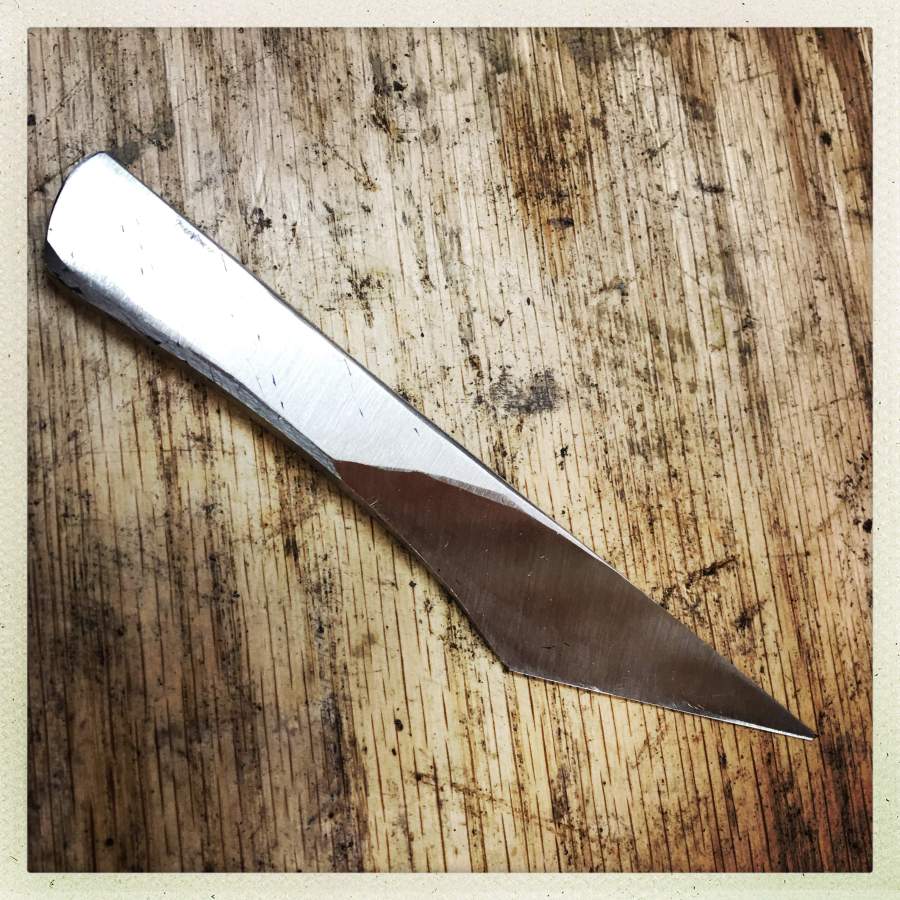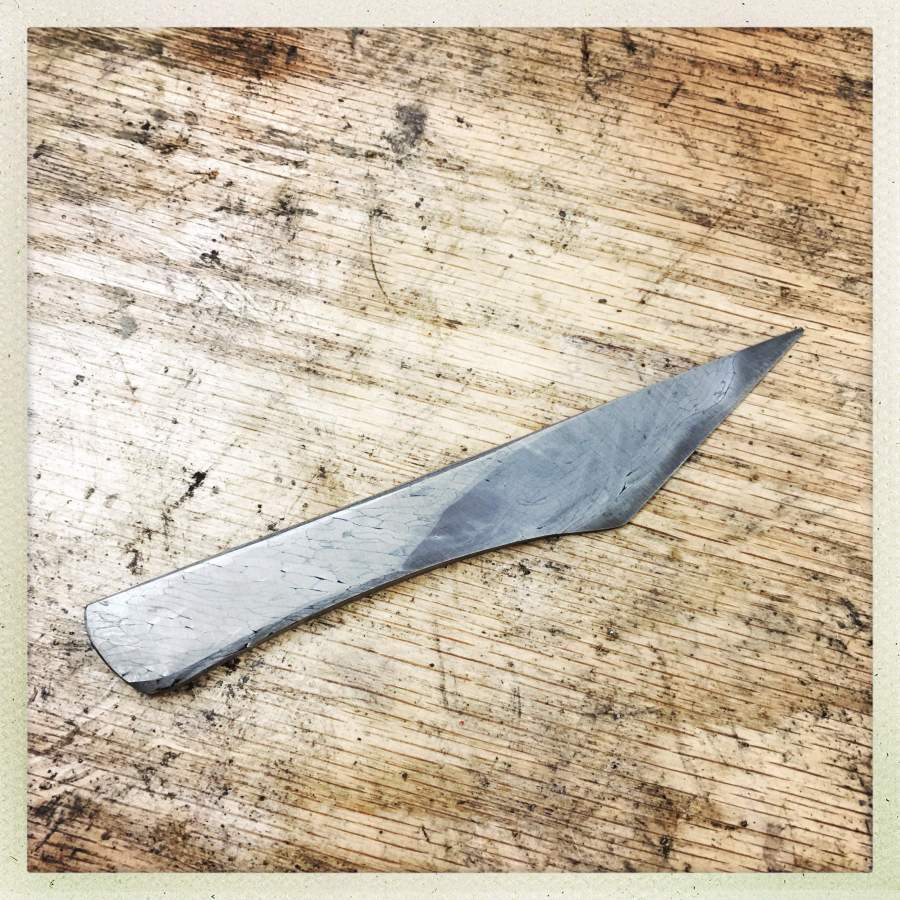I’ve been continuing to experiment with welding, and have tried to actually make a few things out of some of the steels I’ve been assembling.
The news is mixed. My super-duper technique for making forge-welded san mai billets is categorically not super-duper. There is something wrong and it’s not working; I continue to experiment and try to figure out what is going on. It could just be a bad idea, but I still think the physics are on my side. The last attempt appears to have failed because water was driven from the furnace cement into the space between the plates, preventing it from welding. “If it wasn’t frustrating, it wouldn’t be worth doing,” is my motto for that particular project. That and, “make haste slowly.” I force myself to remember that 1) if it was easy, everyone would have figured it out, already and 2) it may just not work, which would certainly explain why nobody else has figured it out.
To preserve my sanity I’ve done a couple of other small projects I can succeed at. Results have been mixed.
The forge-gods chose to remind me that “your welds must be clean” – I spent several hours cutting and shaping this blade, quenched and heat-treated it (that part came out great) and then right when I got to the place where I wanted everything to be just right, it appears my weld is bad:

Well, I like the shape, anyway. But it’s not worth any more work. It’d still sharpen and polish up fine, but I’d know it was junk, so that’s unacceptable. That blade was ground from an early experiment in dry-welding and I have been being more careful with my pre-weld cleaning and prep, anyway. So I am hopeful that I can put that painful mistake into the past.

That’s a piece of cable damascus, ready to get welded onto one side of a bar of 1095. I just love the internal structure of the metal, with all the mooshed-up cable bits. It looks like some kind of dragon-skin or something. To get the texture of the metal to come out, I etch it lightly in ferric chloride.
One thing I’ve learned is that WD-40 is an essential ingredient for everything. Since cleaning the surfaces is so important, keeping them from oxidizing before you get them into the forge is crucial; that’s WD-40’s job.
Some forge-welders use kerosene as a flux, but they also use it for long-term storage of billets that are ready to go into the oven. I guess that also helps prevent oxidation. There’s a problem: when you prep-weld your billet with your MIG welder, it’s really hot and it’s oxidizing merrily. That’s when you both want to and don’t want to drop it into kerosene. Timing is everything and it’s all dominated by physical law. I keep begging that an exception be made for me, but it’s not happening.

That’s a chunk that I assembled in a two-stage process. First, I made a small billet of cable damascus (like the one shown above) then cleaned and prepped it and prep-welded it with the MIG to a bar of 1095. I then welded those together, giving me a bar that’s pretty complicated inside. It quenched and tempered just beautifully, and didn’t explode or bend, which is often a problem with bimetal – I think that having hammered the cable damascus flat it hasn’t got much orientation left to try to spring back into. Unlike the little fish knife with the crack on the edge, that’s a very clean weld.
After a few minutes in the chloride you can see the layout of the metal: the black down at the edge is the 1095 at about Rockwell Hardness Scale 60, and the cable is “soft” comparatively, because I differentially quenched it in a clay blanket. There is actually a temper-line and an edge of completely different metal.

I’m trying to decide how to polish it. I can:
- Etch the whole thing heavily and just polish/sharpen the very edge
- Etch the whole thing heavily and polish the entire bevel
- Leave it nice and shiny and let time and sweat and chemistry slowly reveal the inner structure of the metal.

The cable damascus does look gorgeous, as you say like dragon skin or some other exotic beast.
If that’s the size I guesstimate it is, I would polish it and use it as a kitchen utility knife. After a decade or two of cutting citrus and tomatoes and whatnot, it should reveal the inner beauty.
What good is a glass dagger?
That is very lovely. Do as you wish with this one and make a few dozen more for the commentariat?
Raucous Indignation@#4:
That is very lovely. Do as you wish with this one and make a few dozen more for the commentariat?
I’ll probably do more experiements. Free-grinding this thing took about 4 hours – that’s a lot of metal to remove!
I’m designing a grinder specifically to carve Japanese-style cooking knives. Maybe when I have that done, I’ll have a better handle on what metallurgy I like for these. Today I welded up some wrought iron and 15N20 edge-pieces; those have some very interesting potential, too.
chigau@#3:
What good is a glass dagger?
dashdsrdash@#2:
If that’s the size I guesstimate it is, I would polish it and use it as a kitchen utility knife. After a decade or two of cutting citrus and tomatoes and whatnot, it should reveal the inner beauty
That’s the option I chose. I spent a while more surfaceing the face on 2000grit wet paper and it came out pretty much mirror-polished. Looks nice; it’ll age well. I’m not sure if I’ll hang onto it or not.
It’s actually fairly small – about 3″ A lot of the size of the blade gets dictated by how much billet you make and how you manipulate it. Since these are tests, they tend to be smallish.
The face-grinding I did also cleaned up that grind-line on the transition at the top of the blade. That was driving me nuts.
Small kitchen knives are jolly useful and quite difficult to find. The smallest I could find is about 3″ and I’d really like one about about the length of my thumb, 2 1/4″ at the most. It’s for cutting out the eyes from potatoes, taking the cores out of tomatoes, coring apples, all the things you do holding the vegetable or fruit in one hand while working on it. Doing that sort of thing with a long knife is just dangerous.
WD-40 is kerosene, with a few additives to let it come out of an aerosol can and not gum up quite so fast.
Don’t Ask Me How I Know This.
fusilier
James 2:24